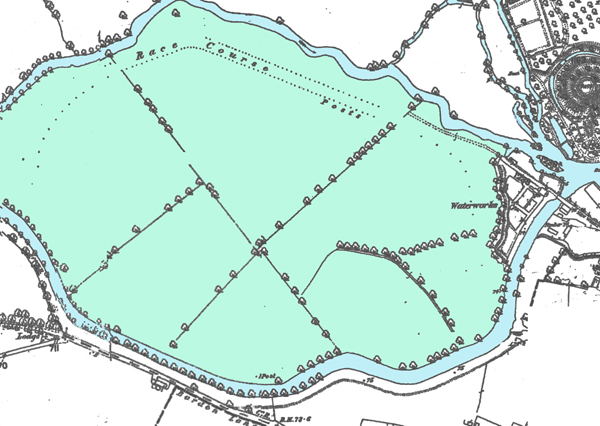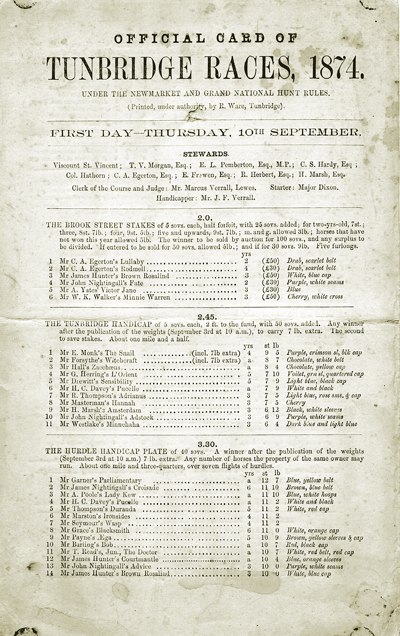Tonbridge Races
In July 1850 Tonbridge people learned that horse-racing was
coming to the town. A one-day meeting was planned for 14th August, when three
races would be run on a Course marked out on fields near the castle. (The area
is now known as The Racecourse Sportsground, but was in private hands in 1850.)
Not everyone was pleased about this development. According
to a local paper, the South Eastern Gazette, ‘considerable excitement has been
manifested in this town, for some weeks past, regarding the races advertised to
take place on the 14th inst., many respectable inhabitants having
protested against them publicly, believing them to be prejudicial to the best
interests of the town’. Detractors even arranged a rival attraction to keep
‘great numbers of children away from the races’, by treating ‘children belonging
to the National and Independent Schools … with plumcake, &c., in a field near
the Pinnacles’.
'The racing was ... excellent'
The local opposition only made the organisers more
determined, and detailed plans were prepared. No gambling booths or tables were
allowed, and no refreshment booths unless by consent of the committee. Entrance
to the Course was 2s 6d for four wheeled carriages and 1 shilling for two
wheeled carriages and saddle horses. The South Eastern Railway offered tickets
to Tonbridge at a flat rate from London, Dover, Ramsgate, Canterbury and all its
other stations.

Late 19thC map showing the position of the race course. The Castle is at top right.
In the event the meeting went off well. The Gazette
reported that ‘the racing was considered to be excellent.’ Six horses started in
the first race, the Town Plate. Next came the Hurdle race in which ‘the whole of
the horses [took] the leaps in first-rate style’. The last event, a Sweepstake,
was an ‘admirable race’. The Course itself was described as ‘one of the best
that could be imagined, situated between two arms of the river Medway; it
commanded one of the most delightful prospects imaginable. The castle, with its
ancient keep, the beautiful woodland scenery which adorns the sides of
Quarry-hill, interspersed with fields of golden grain, were objects well
calculated to feast the eyes of the assembled thousands, independent of the
attractive sports of the field’. Afterwards ‘a number of gentlemen met together
at the Rose and Crown Inn, where a most excellent dinner was provided …’
Annual event
The annual race meeting would grow to be a major event in
the Tonbridge calendar for the next 24 years. In 1851 ‘weather, attendance, and
sport’ combined to ensure success. ‘In addition to an immense number of
fashionables from the Wells, the county folks thickly assembled for the purpose
of being participators in this truly exciting and interesting enjoyment’. For
the 1855 meeting, when the day was ‘exceedingly fine’ and the racing
‘exceedingly good’, ‘large numbers of visitors poured into the town from the
railway station, and many in their respective vehicles from the villages
adjacent. It is calculated that during the afternoon there were between 5 and
6,000 persons assembled on the ground. Many of the carriages of the neighbouring
gentry were on the ground, and the Stewards' and Visitors' Stands were crowded.
There were several refreshment booths, all of which were well filled, the
principal one adjacent to the Grand Stand being that of Mr. R. Montague, the
Bull Inn. Edmond's Menagerie [a travelling zoo] and numerous other exhibitions
of a minor description were on the ground, and appeared to receive their full
share of public patronage’.
A magnet for petty criminals
From the start, the races seem to have been something of a
magnet for petty criminals. In 1850 a pickpocket, Edward Barratt, was seen at
Tonbridge Races ‘attempting the pocket of several persons, and while committing
this robbery was apprehended’. He was sentenced to six months’ hard labour. On
the same evening Peter William Russell and John Holman were charged with
tendering a false half-crown at the Rose and Crown tap. They had come down from
London by train with two other men, knowing it was race day. A parcel containing
50 counterfeit half-crowns, all dated 1844, was found among their possessions.
Both men were committed for trial. By 1855 help was needed to keep the peace,
and ‘a body of metropolitan police (R division) under the direction of Sergeant
Pearson were in attendance.’

1874 Racecard
Tonbridge Races continued at least until 1874, in which
year Sporting Life reported that ‘the easy distance from London attracted many
metropolitan ‘turfites’ and on each day there was a good attendance, while the
course was good going and the sport fairly up to the average … The weather was
showery on both days, but the local support both in ‘lads and lassies’ was as
notable as ever’. According to the same report, ‘racing has not a very strong
hold in Kent, although the county generally is noted for its encouragement of
sport.’ Tonbridge had ‘gone some way to redeem the failings of the … Canterbury
Races held earlier that year.
Despite the apparent success of the 1874 meeting, no later
mention of the Tonbridge Races has been found.


